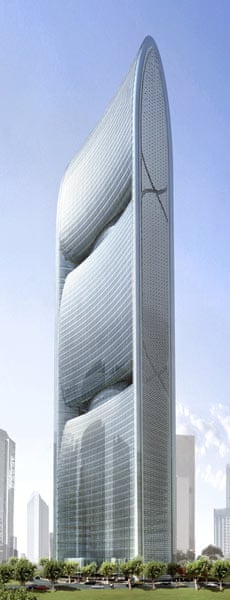You can see the carbon emissions rising by the day over the skyline of Guangzhou, where armies of construction workers are busy throwing up skyscrapers that will soon surpass anything in New York in terms of height and energy consumption.

It is the same story all over China where, despite the economic crisis, engineers are completing four more tower blocks every day – almost all fitted with air conditioning, heating, lighting and lifts that will run on coal-powered electricity.
The country is in the middle of the greatest building boom in human history. Six of the world's 10 tallest buildings completed last year were in China, including the 492-metre-tall Shanghai World Financial Centre. Even taller structures are on their way – such as the Shanghai Centre, 632 metres, and at 600 metres, the Goldin Finance 117 in Tianjin.
But among the giants there is one that could hold out hope for a low-carbon future. The Pearl River Tower, now being erected in Guangzhou, the provincial capital of Guangdong province, is being billed as the most energy efficient superskyscraper ever built.
With wind turbines, solar panels, sun-shields, smart lighting, water-cooled ceilings and state-of-the-art insulation, the 310-metre tower is designed to use half the energy of most buildings of its size and set a new global benchmark for self-sufficiency among the planet's high rises.
Engineers say the tower could even be enhanced to create surplus electricity if the local power firm relaxes its monopoly over energy generation.
Due for completion in October 2010, the structure currently looks no different from the many other masses of steel and concrete that are reaching for the sky in Guangzhou.
The horizon is rising fast and grey in China's wealthiest province. By the time the Asian games begin next year, the provincial capital will boast a 432-metre-high TV tower, excluding its 150-metre antenna, and the 391-metre Zhongxin Plaza. Both structures will be bigger than any building in New York.
While Dubai and other cities in the Middle East are building a handful of still loftier structures, nowhere can compare with China for the sheer mass of supertowers being planned or under construction.
One management consultancy firm estimates that China will erect up to 50,000 new skyscrapers by 2025. Along with smaller structures, McKinsey estimates that buildings will account for 25% of China's energy consumption by then, up from 17% today.
More efficient buildings could drastically reduce this demand, though few are likely to go as far the 71-storey Pearl River Tower, which combines many of the world's leading energy-saving technologies on a scale never seen before.
The most spectacular feature will be the four wind turbines built into the belly of the structure. The building has been shaped to drive air through the cavities at maximum velocity so the turbines can generate 1m kilowatt hours of electricity a year. The building will also produce electricity via the photovoltaic cells of the solar shades cooling its east and west facades.
The biggest contribution to energy efficiency will come from the radiant ceiling technology, which uses piped water to keep the internal space cool. Energy will also be extracted from the difference in air temperature between the building's inner and outer walls. Rather than use fans to recirculate old air, fresh air will be delivered to every floor through natural buoyancy.
According to Skidmore, Owings & Merrill, the US architectural firm behind the design, the energy efficiency devices add about $13m (£8m) to the construction costs. But this could be earned back within five years by reduced electricity bills, lower maintenance costs and extra rent from the space not used for air conditioning ducts.
Roger Frechette, the firm's chief engineer, estimates the tower will reduce energy consumption by 58% compared with a standard building this size.
Under the initial design for a "zero-emission skyscraper", it could even have generated surplus energy with micro-turbines that could sell electricity back to the grid at night. But this proposal was dropped after opposition from the local utility company, which is cautious about allowing rival sources of power generation.
This may change. Faced by a deteriorating environment, uncertain world energy supplies and pressure to act on climate change, the Chinese government is trying to shift towards a more sustainable model of development. It is experimenting with ecocities and introducing new green building codes.
Guangzhou is following this trend. As the workshop of the world, the city has a reputation as a humid, heavily polluted sprawl. But it is trying to change this by building taller structures as well as improving the infrastructure for service industries.
"We are trying to make our city more energy efficient. In the past, we expanded too fast. That was a mistake we are trying to correct now," said Chen Qing, the deputy director of the city's Urban Planning and Research Centre.
Not everyone, however, is convinced that skyscrapers are the best way to achieve the city's green goals, given that the Pearl River Tower will be built with 26,500 tonnes of steel and more than 40,000 cubic metres of concrete, and that its main tenant will be a tobacco company.
Meng Qinglin, a professor at the environment and energy laboratory of the South China University of Technology, says urban planners are following global fashions without paying sufficient attention to whether low emission buildings are what they claim to be.
"There is a misconception that buildings can generate sufficient wind and solar power for themselves. We need to look deeper at how much pollution is caused and how many resources are used in the development and manufacture of those technologies," he said.
"They call it clean energy, but often the burden is simply being shifted to other places, where the silicon is mined and the turbines and solar panels are made."